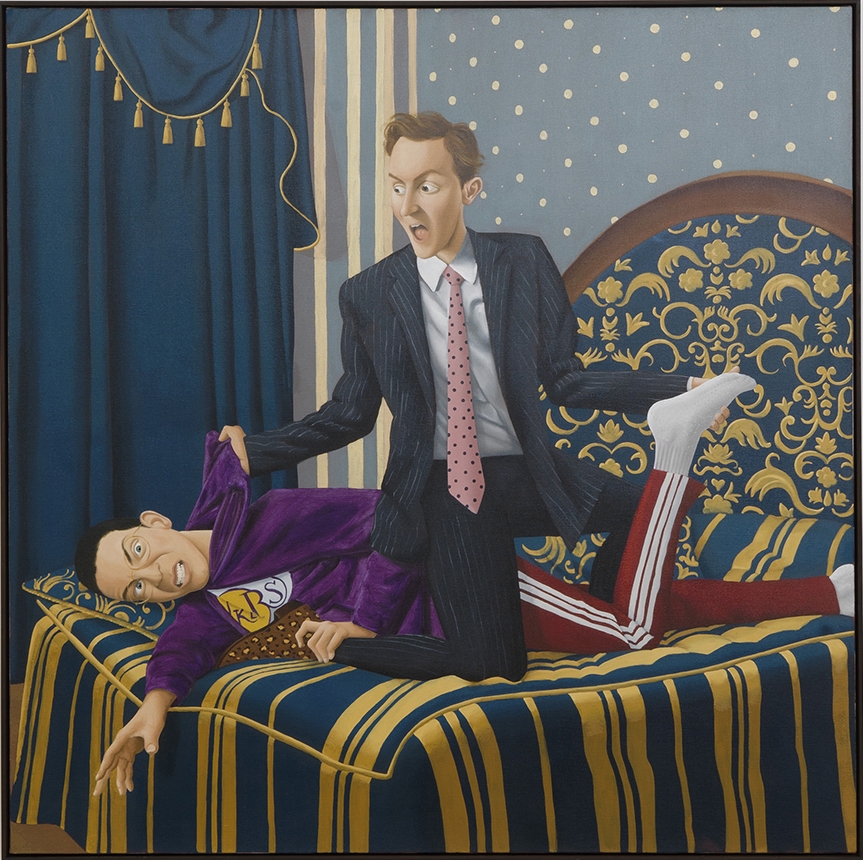Patrizio Di Massimo’s oil paintings are well-oiled machines of conceptual playfulness. They make me think of the historical Italian theatre genre commedia dell’arte – whose name is easily mistranslated as ‘the comedy of art’, when ‘the comedy of profession’ is closer. Indeed, the protagonists here – at this nonprofit, Cura magazine-affiliated space – are artists, art professionals and art history. The London-based Italian artist presents them as characters dressed up in gaudy, trendy costumes, frozen in dramatic poses, against theatrical sets enclosed by velvet curtains. The palette is bold, the outlining sharp, the detailing clinical, as if under a spotlight. Love, hate, wrath and desire abound, together with spectacle, histrionics, melodrama and irony, as in the comic plays performed by the likes of Harlequin, Columbina or Pantalone. As in Mozart’s Don Giovanni (1787), libido is a prima donna of Di Massimo’s stage, where nudity, enslavement and bondage embody the sadomasochistic implications of all relationships. It’s a theatre of the self, where the classic ménage à trois between Me, Myself and I – aka Ego, Id and Super-Ego, in Freudian terms – is interpreted by personifications of the artist himself, his wife (the curator Nicoletta Lambertucci) and their family and friends, attired in different guises.
Di Massimo’s new paintings add to his ongoing ‘quarrel series’. In Prussian Love (all works but two 2019), the two contenders are collectors Alan Prada and Fabio Cherstich; in Bauhau, it’s the artist Goshka Macuga and her partner Nabil Bouhir, who grip each other’s clothes in front of their dog (‘bau-bau’ is how a dog barks in Italian). Di Massimo also plays with art history: Macuga’s Adidas tracksuit, for instance, is decorated with Roy Lichtenstein motifs, while Epico Cavalleresco (After Joseph Paul Blanc) [Knightly Epic (After Joseph Paul Blanc)] appropriates kitsch mid-nineteenth-century French art pompier, substituting the Christian knight Ruggiero with a fierce Chinese youxia she-warrior in the role of the rescuer of the seductive Angelica. In Untitled (Green Triptych) Di Massimo appears variously unclothed or scantily clad in lingerie, enslaved to female dominatrices, amid torture and pleasure. If the erotic imagery clearly pays homage to the brothers Balthus and Pierre Klossowski (whose wife Denise served as model for Roberte, the serial protagonist of the artist’s titillating compositions), the surreal, suspended atmosphere of the scenes refers also to another famous pair of Italian painters and brothers: Giorgio de Chirico and Alberto Savinio, whose Monumento ai Giocattoli (Monument to Toys, 1930) has inspired Di Massimo in the past. The lesser-known magic realist Antonio Donghi comes to mind too, with his eerie repertoire of clowns, jugglers and carnivals that peaked during the years of the fascist regime.
In the monumental Self-Portrait as abstract painter (after Annie Leibovitz) Di Massimo casts himself as the alter ego of a famous comedian. Reproducing a 1981 Rolling Stone cover, it depicts Steve Martin in a white tuxedo smeared with black paint, posing in front of a large black-and-white composition by Franz Kline (an artist present, at the time, in Martin’s own collection). Di Massimo, instead, turns Kline’s black into a fruity, feminine, gelatolike pink. To me, though, the key to the entire show lies in the smallest and most intimate portrait of the group, installed in front of the entrance, like an overture. Diana (6 months) depicts the artist’s newborn child and her cartoonishly puzzled look, as if the adult world, and all its fantasies and ghosts, were nothing more than an opera buffa.
Patrizio Di Massimo, Kura, Milan, 25 September – 20 November 2019
From the January & February 2020 issue of ArtReview
